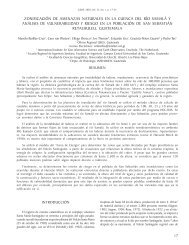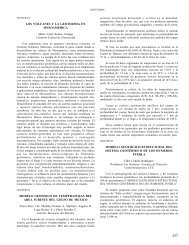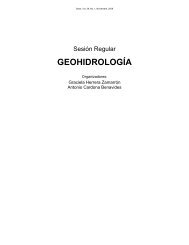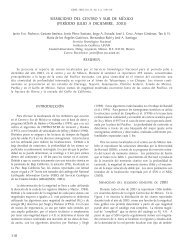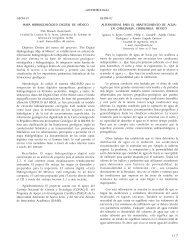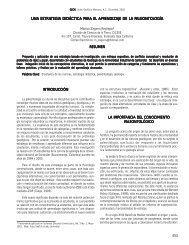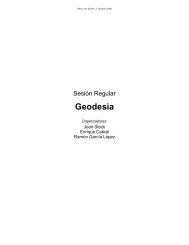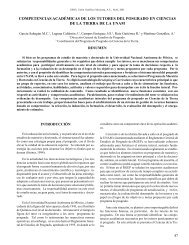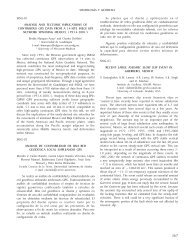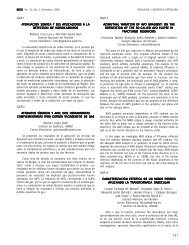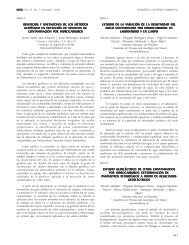OCEANOLOGÍA Geos, Vol. 27, No. 1, Octubre, 2007OCE-1ANALYSIS OF 3-D RING STRUCTURE BASED ONTHEORETICAL MODEL AND SATELLITE DATA:APPLICATION FOR NORTH BRAZIL CURRENT RINGSBulgakov Sergei 1 , Beloiyarov Alexandre 2 , MakarovViacheslav 3 , Cruz Gómez Raúl 4 y Virgen Partida Cristopher 51 Instituto <strong>de</strong> Astronomía y Meteorología, Universidad <strong>de</strong> Guadalajara2 Computational Service Center3 Centro Interdisciplinario <strong>de</strong> Ciencias Marinas, IPN4 Posgrado en Ciencias <strong>de</strong>l Mar y Limnología, UNAM5 Departamento <strong>de</strong> Física, Universidad <strong>de</strong> Guadalajarasbulgako@cencar.udg.mxAnalysis of 3-D ring structure with a methodological approachcombining theoretical mo<strong>de</strong>ling and the application of satellitedata is proposed. The theoretical part consists of linear andnon-linear reduced-gravity mo<strong>de</strong>ls of the lens-like vortices. Theprincipal ring parameters required for the mo<strong>de</strong>l were <strong>de</strong>rivedfrom satellite data (altimetry, SST and drifter information) usingmethod of minimization of the multivariable objective functions.The application of this methodology for one of the North BrazilCurrent (NBC) rings observed in February-March 1999 haspermitted an evaluation of ring geometry and an estimateof transport characteristics. Comparison of the predicted 3-Dring structure and subsurface direct observations has showncongruence between mo<strong>de</strong>l results and experimental data. Thissuggests that present methodology is suitable for evaluation ofthe mass transport by NBC rings, an important component of theAtlantic meridional overturning circulation.OCE-2THE FLOW OFF THE NW GULF OF MEXICO SLOPEBEFORE ONCOMING LOOP CURRENT EDDIESCan<strong>de</strong>la Pérez Julio 1 , Badan Antonio 1 , Zavala Barbara 1 ,Sheinbaum Julio 1 , Ochoa José 1 y Rivas David 21 División <strong>de</strong> Oceanología, CICESE2 Oregon State University, USAjcan<strong>de</strong>la@cicese.mxFourteen months of direct surface to bottom currentmeasurements off the slope of the NW Gulf of Mexico capturethe evolution of currents as an oncoming warm Loop Currenteddy disintegrates off the coast and interacts with the near-shoreflow. In general, current fluctuations, typically 20-25 cm.sec-1, areabout 2 to 4 times their mean. Currents at the edge of the shelfare strongly influenced by topography, often in the shape of acoastal flow, but with active exchange with <strong>de</strong>eper waters. In theupper layers, energy increases offshore, with a clear influencefrom eddies to a <strong>de</strong>pth of about 800 m. Further at <strong>de</strong>pth, asouthward flow appears to be locked to the slope in the form ofa countercurrent over the 2000 m isobath, whereas in <strong>de</strong>eperwater motions are somewhat more energetic and support earlierinvestigations that showed the prevalence of bottom-trappedtopographic waves. The spectrum of motions in the upper layersis very energetic in the 60 to 100 day bands, which are thereforemarginally resolved, which casts some uncertainty on the directionof the mean flow. Some short-lived, high frequency events are welldocumented by our observations.OCE-3CIRCULACIÓN DURANTE EL OTOÑO-INVIERNO DE2006-2007 EN EL SISTEMA ARRECIFAL VERACRUZANOZavala Hidalgo Jorge 1 , Martínez López Benjamín 1 , Fernán<strong>de</strong>zEguiarte Agustín 2 , De Buen Kalman Rebeca 1 , Rojas Julio 1 , MateosJasso Adriana 1 , Allen<strong>de</strong> María Eugenia 1 y Vargas Juan Manuel 31 Centro <strong>de</strong> Ciencias <strong>de</strong> la Atmósfera, UNAM2 Instituto <strong>de</strong> Geografía, UNAM3 Centro <strong>de</strong> Ecología y Pesquerias, UVjzavala@atmosfera.unam.mxSe analizan datos <strong>de</strong> corrientímetros, medicioneshidrog#aficas y mo<strong>de</strong>lación numérica para <strong>de</strong>terminar lospatrones <strong>de</strong> circulación en la región <strong>de</strong>l Sistema ArrecifalVeracruzano (SAV), Veracruz, México, durante el otoño-invierno<strong>de</strong> 2006-2007. Los resultados muestran que el forzamientoprincipal en la región es la componente <strong>de</strong>l esfuerzo <strong>de</strong>l viento alo largo <strong>de</strong> la costa. La contribución <strong>de</strong> las mareas es un or<strong>de</strong>n<strong>de</strong> magnitud menor.OCE-4VALOR INTRÍNSECO DE IMÁGENES DINÁMICASDE LA TEMPERATURA DE LA SUPERFICIE DELMAR EN ESTUDIOS COMPLEMENTARIOS DELA OCEANOGRAFÍA REGIONAL DE LA ZONAECONÓMICA EXCLUSIVA DE MÉXICO: DOS EJEMPLOSGallegos García Artemio 1 , Rodríguez SobreyraRanulfo 1 , Lecuanda Raymundo 1 y Zavala Hidalgo Jorge 21 Instituto <strong>de</strong> Ciencias <strong>de</strong>l Mar y Limnología, UNAM2 Centro <strong>de</strong> Ciencias <strong>de</strong> la Atmósfera, UNAMgallegos@mar.icmyl.unam.mxLa temperatura <strong>de</strong> la superficie <strong>de</strong>l mar (TSM) es la ‘huelladigital térmica’ que imprimen diversos procesos mecánicos ytermodinámicos que suce<strong>de</strong>n en la interfase océano-atmósfera.Los valores <strong>de</strong> intensidad y distribución <strong>de</strong> la TSM los <strong>de</strong>terminanlos flujos verticales <strong>de</strong> momento, masa y energía entre lacapa límite atmosférica y el estrato superficial <strong>de</strong>l mar. Elpresente trabajo exhibe, examina y propone el uso <strong>de</strong> imágenesdinámicas <strong>de</strong> la TSM como una herramienta complementariay <strong>de</strong>terminante en el estudio <strong>de</strong> la oceanografía física <strong>de</strong> lasdiversas regiones marinas <strong>de</strong> la Zona Económica Exclusiva<strong>de</strong> México (ZEEM). El análisis <strong>de</strong> la evolución temporal quemuestran distribuciones específicas <strong>de</strong> la TSM tanto en elPacífico mexicano como en el Golfo <strong>de</strong> México, plasmadasen imágenes dinámicas, permite <strong>de</strong>scubrir e i<strong>de</strong>ntificar unadiversidad <strong>de</strong> formas y estructuras térmicas cuya dinámicaparece estar asociada, en algunos casos, a la conformacióngeográfica local <strong>de</strong> la cuenca o litoral; o a la estación <strong>de</strong>l año.En otros casos, las distribuciones térmicas parecen respon<strong>de</strong>ra procesos <strong>de</strong> regularidad estacional o interanual, a escalaregional. También, superpuestos a tales configuraciones, seobservan rasgos térmicos <strong>de</strong> menor tamaño, que cambian másrápido, día a día, asociados al carácter eminentemente turbulentoque manifiestan y que son propios <strong>de</strong> los procesos físicos <strong>de</strong>locéano y la atmósfera. Tales expresiones térmicas <strong>de</strong>finen, enfunción <strong>de</strong> su dominio geográfico y persistencia, los caracteres <strong>de</strong>las condiciones oceanográficas locales y regionales. Son estasexpresiones las que sugieren profundizar en el análisis <strong>de</strong> la92
Geos, Vol. 27, No. 1, Octubre, 2007OCEANOLOGÍAevolución <strong>de</strong> las distribuciones espacio-temporales <strong>de</strong> la TSMpara <strong>de</strong>scubrir, i<strong>de</strong>ntificar y <strong>de</strong>sarrollar una regionalización marina<strong>de</strong> la ZEEM.OCE-5CONSTRUCCIÓN DE IMÁGENES DINÁMICASDE LA TEMPERATURA DE LA SUPERFICIEDEL MAR (TSM) DE LA ZONA ECONÓMICAEXCLUSIVA DE MÉXICO A PARTIR DE PROMEDIOSMENSUALES PONDERADOS DE ESTA VARIABLERodríguez Sobreyra Ranulfo 1 , Gallegos García Artemio 1 , ZavalaHidalgo Jorge 2 , Zavala Romero Olmo 2 y Mateos Jasso Adriana 21 Instituto <strong>de</strong> Ciencias <strong>de</strong>l Mar y Limnología, UNAM2 Centro <strong>de</strong> Ciencias <strong>de</strong> la Atmósfera, UNAMranulfo@mar.icmyl.unam.mxUna secuencia <strong>de</strong> imágenes satelitales <strong>de</strong> la temperatura <strong>de</strong>la superficie <strong>de</strong>l mar (TSM) <strong>de</strong> los mares <strong>de</strong> México, or<strong>de</strong>nadacronológicamente, permite visualizar la evolución temporal <strong>de</strong>su distribución térmica. En estas secuencias consi<strong>de</strong>radas comoimágenes dinámicas se pue<strong>de</strong>n <strong>de</strong>scubrir, i<strong>de</strong>ntificar y ubicaruna diversidad <strong>de</strong> formas y estructuras, plasmadas en laTSM, cuyo movimiento obe<strong>de</strong>ce a forzamientos mecánicos ytermodinámicos diversos y también, a condiciones <strong>de</strong> frontera<strong>de</strong> escala local y regional. Los registros satelitales diariosy consecutivos <strong>de</strong> la TSM tienen limitaciones tales que consólo estos datos no se logra cubrir el área geográfica <strong>de</strong>interés <strong>de</strong> manera simultánea, y en consecuencia no se tieneni la continuidad ni la congruencia necesarias para po<strong>de</strong>rexpresar la evolución temporal <strong>de</strong> las estructuras térmicas en lasuperficie <strong>de</strong> los mares <strong>de</strong> México. Es entonces necesario recurrira procedimientos matemáticos <strong>de</strong> interpolación que permitanrecuperar la continuidad y la congruencia <strong>de</strong> los movimientos <strong>de</strong>las formas térmicas <strong>de</strong> la TSM en esta gran región pero que ala vez preserven la certidumbre <strong>de</strong> los mismos. En este trabajose presenta el método <strong>de</strong> interpolación, basado en Sumas <strong>de</strong>Fourier, utilizado en la construcción <strong>de</strong> la imagen dinámica <strong>de</strong>un ciclo anual <strong>de</strong> la TSM en los mares <strong>de</strong> México, es <strong>de</strong>cir, lasecuencia <strong>de</strong> 365 imágenes interpoladas (diarias) <strong>de</strong> referencia.Las animaciones que se exhiben tienen la necesaria continuida<strong>de</strong>n el movimiento, la congruencia visual esperada y la certidumbre<strong>de</strong> ajustarse a los promedios mensuales.effects of instability of the tidal mo<strong>de</strong>s due to the general increasein world temperature, with its associated recession of polar iceboundaries and rising of mean sea level, are investigated. Thepossible effects of mo<strong>de</strong>rn harbour <strong>de</strong>velopments, as suggestedby Doodson (1924) are also consi<strong>de</strong>red.OCE-7TELEMETRIA CON GPRS ENESTACIONES MAREOGRAFICASGonzález Hermosillo Arturo 1 , Hernán<strong>de</strong>z Rubi Jaime 1 ,Gómez Naranjo Humberto 1 y Sánchez Zamora Osvaldo 21 Instituto <strong>de</strong> Investigaciones en MatemáticasAplicadas y en Sistemas, UNAM2 Instituto <strong>de</strong> Geofísica, UNAMosvaldo@ollin.igeofcu.unam.mxLos avances en re<strong>de</strong>s <strong>de</strong> datos inalámbricas han impactadoen el <strong>de</strong>sarrollo <strong>de</strong> sistemas <strong>de</strong> telemetría. Los sistemas SCADA(Supervisory Control and Data Adquisistion) aplicados a re<strong>de</strong>smareográficas y estaciones meteorológicas, han sufrido rápidoscambios en su arquitectura y posibilida<strong>de</strong>s <strong>de</strong>bido a los avancestecnológicos en los sistemas <strong>de</strong> comunicaciones.Se presenta un <strong>de</strong>sarrollo aplicado <strong>de</strong> sistemas SCADApara mareografía y estaciones meteorológicas que cuenta conuna arquitectura flexible para la instrumentación <strong>de</strong> diferentessensores y es configurable vía aire, permitiendo obtener datosen tiempo real. Se aplican técnicas <strong>de</strong> compresión para latransmisión <strong>de</strong> las variables <strong>de</strong> interés con un excelenteaprovechamiento <strong>de</strong>l canal <strong>de</strong> comunicaciones. El sistema estábasado en re<strong>de</strong>s locales para el acceso a los sensores y usa lared <strong>de</strong> datos en GPRS (General Packet Radio Service), para elenvío <strong>de</strong> información a la central <strong>de</strong> monitoreo. En el <strong>de</strong>sarrollo se<strong>de</strong>terminan las técnicas <strong>de</strong> uso <strong>de</strong>l canal, la electrónica asociada,programas <strong>de</strong> comunicaciones, el acoplamiento <strong>de</strong> sensores y sedan conclusiones.El software para el <strong>de</strong>spliegue <strong>de</strong> datos y su análisis, hasido <strong>de</strong>sarrollado por el mismo grupo <strong>de</strong> trabajo, cuenta concapacidad <strong>de</strong> <strong>de</strong>spliegue <strong>de</strong> los diferentes estados <strong>de</strong> lossensores y <strong>de</strong> la estación en forma remota, permite hacerconsultas y programación <strong>de</strong> parámetros <strong>de</strong> operación así comolas condiciones <strong>de</strong> operación <strong>de</strong> la estación y los medios <strong>de</strong>comunicación.OCE-6SECULAR CHANGES IN THE HARMONICTIDAL COMPONENTS GLOBALWARMING? MAN MADE CHANGES?Ortiz Figueroa Mo<strong>de</strong>sto y González Navarro IgnacioDivisión <strong>de</strong> Oceanología, CICESEortizf@cicese.mxOCE-8SISTEMA OPERATIVO DE PREDICCIÓN DE OLEAJESalinas Prieto José Antonio 1 , Oropeza RosalesFernando 1 y Padilla Hernán<strong>de</strong>z Roberto 21 Instituto Mexicano <strong>de</strong> Tecnología <strong>de</strong>l Agua2 Universidad Autónoma <strong>de</strong> TamaulipasLong series of sea-level observations 1901-2006 around theworld are analyzed to search for secular changes in the tidalharmonic components. The results confirm long term trends inboth, the amplitu<strong>de</strong> and phase of the semidiurnal ti<strong>de</strong> in thePacific as well as in the Atlantic Oceans. Significant trends upto 40 millimeters per century in amplitu<strong>de</strong>, and phase shifts of6 <strong>de</strong>grees per century were found in the principal semidiurnalti<strong>de</strong>. Consi<strong>de</strong>ring some results of Cartwright (1972), the possiblejsalinas@tlaloc.imta.mxEl sistema operativo <strong>de</strong> predicción <strong>de</strong> oleaje consta <strong>de</strong> tresmo<strong>de</strong>los numéricos: los mo<strong>de</strong>los <strong>de</strong>l oleaje WAM y SWAN y elmo<strong>de</strong>lo <strong>de</strong> la atmósfera MM5. El MM5 proporciona los campos<strong>de</strong> viento para forzar los mo<strong>de</strong>los <strong>de</strong>l oleaje. El mo<strong>de</strong>lo WAMse corre en una malla computacional (baja resolución) sobre elOcéano Atlántico y proporciona las condiciones <strong>de</strong> frontera para93
- Page 1 and 2:
Geos, Vol. 27, No. 1, Octubre, 2007
- Page 3 and 4:
Geos, Vol. 27, No. 1, Octubre, 2007
- Page 5 and 6:
Geos, Vol. 27, No. 1, Octubre, 2007
- Page 7 and 8:
Geos, Vol. 27, No. 1, Octubre, 2007
- Page 9 and 10:
Geos, Vol. 27, No. 1, Octubre, 2007
- Page 11 and 12:
Geos, Vol. 27, No. 1, Octubre, 2007
- Page 13 and 14:
Geos, Vol. 27, No. 1, Octubre, 2007
- Page 15 and 16:
Geos, Vol. 27, No. 1, Octubre, 2007
- Page 17 and 18:
Geos, Vol. 27, No. 1, Octubre, 2007
- Page 19 and 20:
Geos, Vol. 27, No. 1, Octubre, 2007
- Page 21 and 22:
Geos, Vol. 27, No. 1, Octubre, 2007
- Page 23 and 24:
Geos, Vol. 27, No. 1, Octubre, 2007
- Page 25 and 26:
Geos, Vol. 27, No. 1, Octubre, 2007
- Page 27 and 28:
Geos, Vol. 27, No. 1, Octubre, 2007
- Page 29 and 30:
Geos, Vol. 27, No. 1, Octubre, 2007
- Page 31 and 32:
Geos, Vol. 27, No. 1, Octubre, 2007
- Page 33 and 34:
Geos, Vol. 27, No. 1, Octubre, 2007
- Page 35 and 36:
Geos, Vol. 27, No. 1, Octubre, 2007
- Page 37 and 38:
Geos, Vol. 27, No. 1, Octubre, 2007
- Page 39 and 40:
Geos, Vol. 27, No. 1, Octubre, 2007
- Page 41 and 42: Geos, Vol. 27, No. 1, Octubre, 2007
- Page 43 and 44: Geos, Vol. 27, No. 1, Octubre, 2007
- Page 45 and 46: Geos, Vol. 27, No. 1, Octubre, 2007
- Page 47 and 48: Geos, Vol. 27, No. 1, Octubre, 2007
- Page 49 and 50: Geos, Vol. 27, No. 1, Octubre, 2007
- Page 51 and 52: Geos, Vol. 27, No. 1, Octubre, 2007
- Page 53 and 54: Geos, Vol. 27, No. 1, Octubre, 2007
- Page 55 and 56: Geos, Vol. 27, No. 1, Octubre, 2007
- Page 57 and 58: Geos, Vol. 27, No. 1, Octubre, 2007
- Page 59 and 60: Geos, Vol. 27, No. 1, Octubre, 2007
- Page 61 and 62: Geos, Vol. 27, No. 1, Octubre, 2007
- Page 63 and 64: Geos, Vol. 27, No. 1, Octubre, 2007
- Page 65 and 66: Geos, Vol. 27, No. 1, Octubre, 2007
- Page 67 and 68: Geos, Vol. 27, No. 1, Octubre, 2007
- Page 69 and 70: Geos, Vol. 27, No. 1, Octubre, 2007
- Page 71 and 72: Geos, Vol. 27, No. 1, Octubre, 2007
- Page 73 and 74: Geos, Vol. 27, No. 1, Octubre, 2007
- Page 75 and 76: Geos, Vol. 27, No. 1, Octubre, 2007
- Page 77 and 78: Geos, Vol. 27, No. 1, Octubre, 2007
- Page 79 and 80: Geos, Vol. 27, No. 1, Octubre, 2007
- Page 81 and 82: Geos, Vol. 27, No. 1, Octubre, 2007
- Page 83 and 84: Geos, Vol. 27, No. 1, Octubre, 2007
- Page 85 and 86: Geos, Vol. 27, No. 1, Octubre, 2007
- Page 87 and 88: Geos, Vol. 27, No. 1, Octubre, 2007
- Page 89 and 90: Geos, Vol. 27, No. 1, Octubre, 2007
- Page 91: Geos, Vol. 27, No. 1, Octubre, 2007
- Page 95 and 96: Geos, Vol. 27, No. 1, Octubre, 2007
- Page 97 and 98: Geos, Vol. 27, No. 1, Octubre, 2007
- Page 99 and 100: Geos, Vol. 27, No. 1, Octubre, 2007
- Page 101 and 102: Geos, Vol. 27, No. 1, Octubre, 2007
- Page 103 and 104: Geos, Vol. 27, No. 1, Octubre, 2007
- Page 105 and 106: Geos, Vol. 27, No. 1, Octubre, 2007
- Page 107 and 108: Geos, Vol. 27, No. 1, Octubre, 2007
- Page 109 and 110: Geos, Vol. 27, No. 1, Octubre, 2007
- Page 111 and 112: Geos, Vol. 27, No. 1, Octubre, 2007
- Page 113 and 114: Geos, Vol. 27, No. 1, Octubre, 2007
- Page 115 and 116: Geos, Vol. 27, No. 1, Octubre, 2007
- Page 117 and 118: Geos, Vol. 27, No. 1, Octubre, 2007
- Page 119 and 120: Geos, Vol. 27, No. 1, Octubre, 2007
- Page 121 and 122: Geos, Vol. 27, No. 1, Octubre, 2007
- Page 123 and 124: Geos, Vol. 27, No. 1, Octubre, 2007
- Page 125 and 126: Geos, Vol. 27, No. 1, Octubre, 2007
- Page 127 and 128: Geos, Vol. 27, No. 1, Octubre, 2007
- Page 129 and 130: Geos, Vol. 27, No. 1, Octubre, 2007
- Page 131 and 132: Geos, Vol. 27, No. 1, Octubre, 2007
- Page 133 and 134: Geos, Vol. 27, No. 1, Octubre, 2007
- Page 135 and 136: Geos, Vol. 27, No. 1, Octubre, 2007
- Page 137 and 138: Geos, Vol. 27, No. 1, Octubre, 2007
- Page 139 and 140: Geos, Vol. 27, No. 1, Octubre, 2007
- Page 141 and 142: Geos, Vol. 27, No. 1, Octubre, 2007
- Page 143 and 144:
Geos, Vol. 27, No. 1, Octubre, 2007
- Page 145 and 146:
Geos, Vol. 27, No. 1, Octubre, 2007
- Page 147 and 148:
Geos, Vol. 27, No. 1, Octubre, 2007
- Page 149 and 150:
Geos, Vol. 27, No. 1, Octubre, 2007
- Page 151 and 152:
Geos, Vol. 27, No. 1, Octubre, 2007
- Page 153 and 154:
Geos, Vol. 27, No. 1, Octubre, 2007
- Page 155 and 156:
Geos, Vol. 27, No. 1, Octubre, 2007
- Page 157 and 158:
Geos, Vol. 27, No. 1, Octubre, 2007
- Page 159 and 160:
Geos, Vol. 27, No. 1, Octubre, 2007
- Page 161 and 162:
Geos, Vol. 27, No. 1, Octubre, 2007
- Page 163 and 164:
Geos, Vol. 27, No. 1, Octubre, 2007
- Page 165 and 166:
Geos, Vol. 27, No. 1, Octubre, 2007
- Page 167 and 168:
Geos, Vol. 27, No. 1, Octubre, 2007
- Page 169 and 170:
Geos, Vol. 27, No. 1, Octubre, 2007
- Page 171 and 172:
Geos, Vol. 27, No. 1, Octubre, 2007


![Libro de resúmenes [revisión final, 172 páginas] - UGM](https://img.yumpu.com/51565067/92/500x640/libro-de-resamenes-revisian-final-172-paginas-ugm.jpg)
